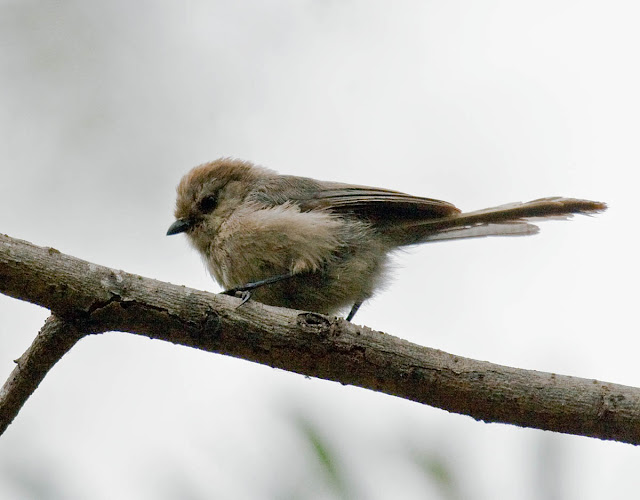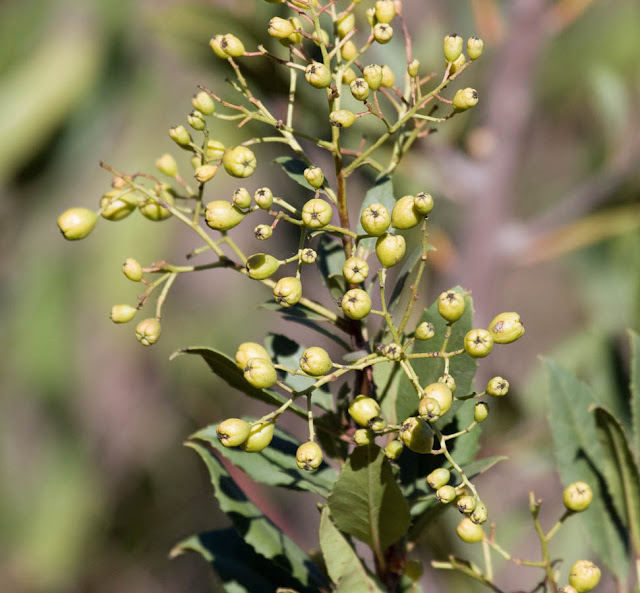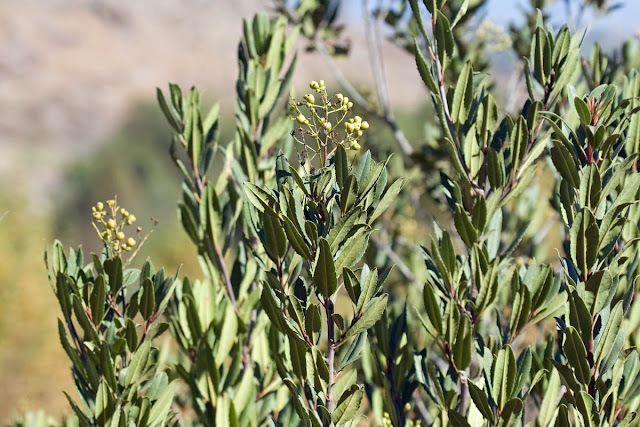Birding and nature around Lake Hodges
November 13, 2016
It was jacket weather when I started at 7:20 am--55F and wispy clouds covering the sun, but nowhere else. I knew it was going to warm up fast, so I birded near the Rancho Bernardo Community Park and near the car to start. That way I could shed the coat for my longer hike.
 |
| Looking south. A view of the partly hazy sky. Cirrus clouds? My meteorology studies in high school were long ago. |
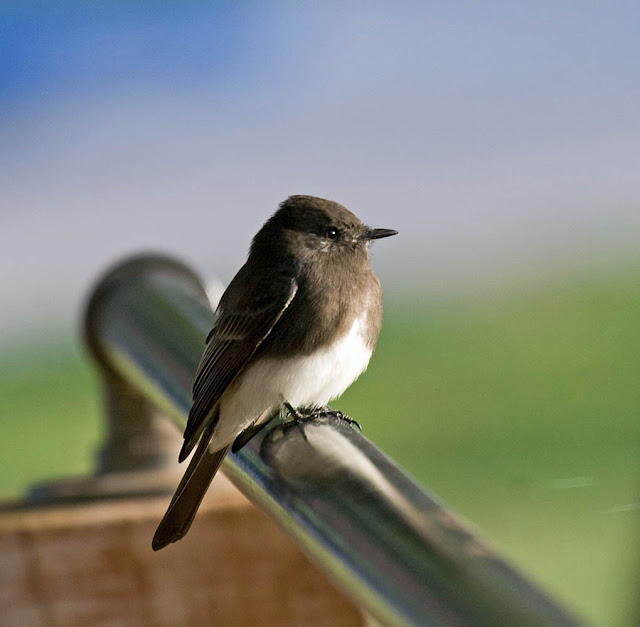 |
| Black Phoebe on parallel bars. Rancho Bernardo, California. November 13, 2016. Greg Gillson. |
 |
| Slightly out-of-focus male Townsend's Warbler. It spent most of its time in the pines and shade. |
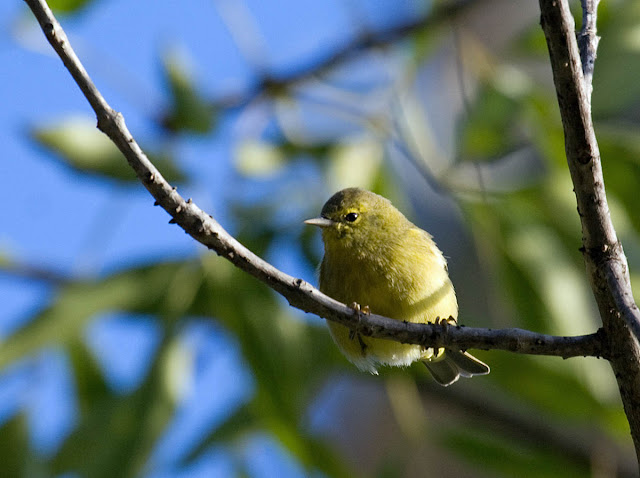 |
| Orange-crowned Warbler |
 |
| Olive-colored chevrons on undertail coverts are exclusive to the Channel Islands breeding race of Orange-crowned Warbler-- Oreothlypis celata sordida. |
Okay, a decent start. I provide the metadata--date, time, location and the weather--photo and description.
I provide some bird photos, two "pretty," two of lesser quality equivalent to quick sketches with comments on behavior, plumage and identification, habitat. Is a jungle gym in a park habitat? I guess it is.
The leaves on the native
sycamore trees were turning golden yellow, orange, and brown and beginning to shed. So I decided to look a bit more closely.
 |
| Playground with sycamores. Many of the leaves have already shed. |
 |
| Sycamore bark is a mottled collage of white, brown, and gray patches. |
 |
| A minority of sycamore leaves are still green. The three to five pointed lobes remind some of maple leaves. |
 |
| The spiky seed balls of sycamore |
This native tree looks superficially like a widespread ornamental, the
sweet gum or liquidambar that is native to the SE US, but planted widely in California. The sweet gum has ridged bark and even spikier seed pods--and, a more colorful red fall leaf display.
The above section does well with a habitat photo, zooming in on the bark, leaves, and seeds. Then I talk about another tree that it reminds me of. This is very definitely what I had in mind as similar to natural history drawings.
The clouds gone and temperatures rising, I left my jacket in the car and continued on.
 |
| Looking west from the parking area. Coastal sage scrub habitat. |
It has been very dry, with only a couple of brief showers since April. Now that we've reached mid-November, most plants are dead or showing signs of stress from prolonged drought. A few bushes have drying flowers.
One bush was especially proliferous with its cottony flowers. After some research I think it may be Coyote Brush.
 |
| Coyote brush? |
 |
| Close up of flowers |
Landscape, bush, flowers--varying the focus on the same item. And I may have identified the previously unknown-to-me shrub.
An archeological discovery here are boulders covered with 500 year old doodles. I couldn't make out any designs, but could see the red ochre color added to the rocks.
 |
| 500 year old rock "chalk board." |
I found a natural piece of colorful art.
 |
| Colorful lichens on a rock. |
Not everyone considers archaeology part of natural history. But there are some traces here of organisms to pass this way long ago--people. The lichen is a comparison--native rock art versus natural rock art.
Here is a giant thistle-like plant, chest tall and 4 inches across or so.
 |
| Unknown flower gone to seed |
I noticed and recorded this. I don't know what it is, other than big. Something to watch for later.
I didn't have the trail to myself, but that was okay.
 |
| Tracks |
I was purposely looking for an example of beauty in nature--light, color, pattern, shapes. I found them here on the trail.
So, here's a question. What's with the microscopic clam shells? This is an old river bank and new lake. Is this dredge spoils from the lake and the clams only are here since the lake was formed? Or are the shells from elsewhere?
 |
| Teeny, tiny shells. 1/8 to 1/4 inch. |
 |
| Ooh, ick! My sand has clams in it! |
 |
| Jimson Weed? The flower bud is 3 inches long. |
Questions are definitely the first part of eventually understanding nature. "A rose by any other name may smell as sweet, but without a name it is simply a flower" (Jim Wright and Jerry Barrack, In the Presence of Nature). The correct identification and naming is also essential to understanding nature. Did I name the plant correctly? Perhaps, and I'm building a catalog of plants and other items I've never noticed before. Or perhaps I did notice, but never wrote it down, and soon forgot.
There are patches of prickly pear cactus on the hillsides. But recently several slopes have been planted with prickly pear. In a year or two it may grow thick enough for Cactus Wrens to colonize on this side of the lake the way they have on the north side.
 |
| Prickly pear cactus alongside the trail. Looking west across the Bernardo Bay arm of Lake Hodges. |
 |
| Prickly pear cactus |
 |
| A Mourning Dove was sitting along side the trail here. Perhaps I interrupted its feeding, but it just sat and looked at me. |
Chamise (Adenostoma fasciculatum) California Buckwheat is a common plant of the chaparral. It appears dark reddish brown from a distance now, as the flowers are mostly dried up and the plant nearly dormant.
 |
Chamise California Buckwheat |
 |
Chamise California Buckwheat |
The endangered California Gnatcatcher is frequently found in the heavier chamise along the Bernardo Bay section of the trail.
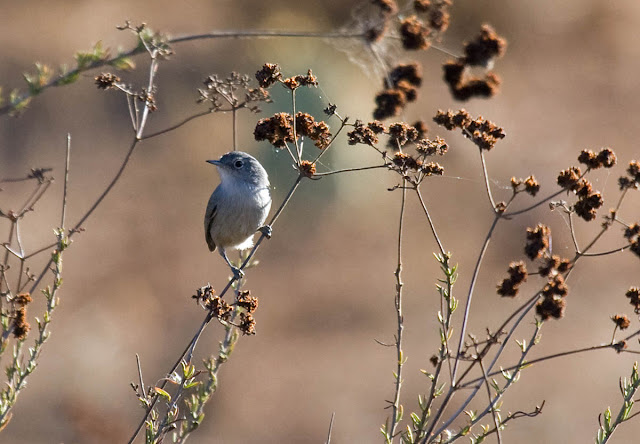 |
| I observe spider webs. Do the gnatcatchers eat the spiders, or do the bird and spider compete for the same insects? Such questions lead to science happening! |
 |
| California Gnatcatcher actively crawling and fly-hopping through the bushes, the long tail flipping about. The undertail is black with thin white edges on the side and tips. It is a diagnostic field mark for identifying this gnatcatcher species--one of three species in San Diego County. |
I found a couple more California Gnatcatchers down the trail a ways. This time in other weeds.
 |
| These weeds look like barbed wire! |
By varying the view I have observed a connection from the landscape/cactus patch on through to the dove and chamise buckwheat and then to the gnatcatchers and spider webs. From there I went on to a species account with poses, identification, and behavior. Most of the gnatcatcher photos are not pretty pictures that could stand by themselves. In the past I would have thrown them away (deleted). But as diagrams that illustrate behaviors and plumage characters, they tell an interesting story. And leave many unanswered questions.
Farther down the trail I came upon several oak trees. These are live oaks, either coast live oak or canyon live oak. They are very similar. A list of plants here (see reference footnote) lists only coast live oak.
 |
| Live oak along the shore of Lake Hodges. |
 |
| The leaves are about 1-1/2 inches long, twice as long as they are wide, and rather oval, with sharp points along the edge. |
 |
| The bark is gray and rough and the trunk gnarled |
At another live oak tree I noticed an adjacent smaller oak shrub with little tiny fingernail-sized round leaves. Is this, perhaps, a scrub oak?
 |
| The live oak in the center of the frame is about 25 feet tall. The scruffy little bush to the right, barely 8 feet tall is another kind of oak, perhaps scrub oak. |
 |
| Tiny little round oak leaves. Scrub oak? |
Here's another set of tree, bark, leaves including a scenic landscape/habitat view for context.
All along the trail I had been seeing these little piles....
 |
| Scat. Feces. Excrement, Poo... |
This particular pile of coyote scat included fur, perhaps of rabbit or ground squirrel, plus these fruit pits. Every pile included lots of these pits. But I couldn't see any plants with berries that these could be from. Finally, after hiking about 2 miles, I found such a bush along the riparian edge. Superficially the bush looked like a willow, but with leathery, thick, serrated leaves,... and the berries. Still don't know the name. [11/27/16--This plant is toyon
Heteromeles arbutifolia.]
I cut open the fruit with my thumbnail and tasted. It had no real taste that I could discern. Many non-edible fruit are very bitter. This was not. So, this is what the coyotes are eating this time of year... whatever it is. [11/27/16--The shrub is Toyon.]
There are many signs of animal presence in nature without actually seeing the live animal. Tracks, trails, scat, browsing or kill signs, marking signs, dens, shed antlers, dead bodies--all these and more indicate that an animal has passed this way. The dog-like droppings with fur and berries? Coyote. The undigested parts gave a clue, and the fact that it was widespread, yet the source was not immediately evident, made it a mystery to be solved.
So that's it. Or so I thought. I had walked about 3 miles and was back to the car 3-1/2 hours later just about 11:00 am. It was up to 92F, about where the temperature would peak for the day. Then I saw the flowerbeds at the parking lot when getting into my car. I had seen a sign on my hike about endangered local plants. One of them was a kind of mint. Could these flower beds be cultivating endangered mint? I mean, when's the last time you saw mint as a flowerbed ground cover?
This ends with more metadata--distance traveled, time, temperature. And then ends with a mystery: is this mint a deliberate planting of a local rare endangered plant, or just a coincidence?
That's the end then. I thought several of the ideas and photo series lent themselves very well to the Nature Journaling theme and practice. The post is more interesting than simply a single pretty picture or two, but likely too long for a single post. I'm sure it could be broken up into themes. Then again, I won't always devote 3-1/2 hours in the field to this Nature Journaling idea. But I can take a nature break any time when I'm out--especially when I notice nature telling me a story. I now have a methodology to use photography as the main art form for Nature Journaling.
References:
Plants of Piedras Pintadas Ridge, Lake Hodges. James Dillane, May, 1997.
My
eBird list for the hike.
My previous
site guide to this part of Lake Hodges.

